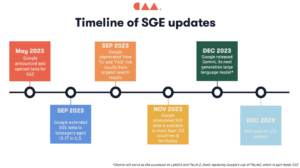Google’s Search Generative Experience isn’t a replacement, it’s an evolution
At Google I/O on May 10, 2023, Google announced the release of its new generative search features as a beta, initially only available to U.S. English users through its Search Labs. Since this announcement, SGE updates have continued to roll out:

The steps Google has taken in 2023 indicate the search marketing leader is preparing for the release of SGE to the public, taking it out of beta within Chrome and making it available for most Google users. With many believing this will happen in the first half of 2024 ahead of Google I/O 2024, now is the time for marketers to prepare for this change.
What is the impact to Google search, or more specifically organic search?
The impact to organic search may be significant depending on the intent of the query and associated results. Up to this point, SGE has primarily focused on producing results related to informational queries. “Informational” is a broad phrase, but includes topics related to FAQs, “how-tos,” entities (person, place, or thing), brands, and more.
For any SGE result, it will be important to keep in mind the source of the content used to generate an AI result and where marketers might have an opportunity to inform or be a part of the generated results. As a reminder, AI-generated content will in part derive from high-ranking content (within the top 10 results) that may be cited within the result, meaning a reference or link to your brand’s content could be included.
Here’s how your brand’s visibility may be impacted by SGE producing results related to informational queries:
- “How-tos” and FAQs: With the removal of “How To” and FAQ-type results from the search engine results page (SERP) in September 2023, it’s very likely Google will replace those result types with SGE. If your website has FAQ or how-to content, it will be important to carefully evaluate it, especially if the website generates visibility (impressions) and traffic for said content. For brands with this content type, visibility will likely decrease not only due to the removal of those result types from the SERP, but also the likelihood that SGE will incorporate that data into its results. That said, if your brand already had visibility for these
types of queries, it likely meant the content is authoritative and will likely continue to be a part of the SGE result. If citations are included in the SGE, the visibility might return to some prior level. - Entity: For most entity-type queries — like “The Rocky Mountains” — the SGE result will likely derive from Wikipedia-style content and possibly news (like Google has done for the Knowledge Graph for years). With the rollout of SGE, we anticipate the most notable change being SGE pushing down the location of the Knowledge Graph in the SERP.
- Brand: Marketers will also want to carefully monitor brand-style content as SGE rolls out to the public. Why? SGE will likely derive its content from the top 10 results, which will likely not be 100% controlled by the brand. But at a minimum, brands should influence this content when possible by ensuring content exists on the brand’s website that can answer users’ relevant brand queries. This means an audit should be completed of common brand questions to ensure content exists to answer them. Otherwise, inaccurate content could feed the SGE result.
Because the content described above falls into the early-funnel stage of the customer journey, the wide launch of the SGE will likely impact early-funnel SEO strategies. That said, the launch will likely shift how marketers think about content within the mid-funnel stage of the customer journey. Consideration searches like comparisons, product questions, and review searches are crucial to engage the searcher, and ultimately to convert a searcher into a customer. Even now, before the SGE is released to the public, winning mid-funnel content includes some traditionally high-funnel content. For example, a high-ranking Medicare plan page that fits within the middle of the funnel now includes high-funnel content like a brief answer to “what is Medicare.” Essentially, optimizing for mid- funnel queries might be the largest opportunity to capture nonbrand traffic as some of the early-funnel content will likely be captured by SGE.
How should marketers prepare?
It’s critical for marketers to proactively prepare for the launch of SGE as it could have more significant impacts to organic performance than previous Google updates. Some of the anticipated negative impacts include:
- Potential loss of impressions and clicks to websites (depending on query intent) when an SGE result is included in the SERP
- Decrease in early-funnel visibility and traffic for informational queries as SGE will likely produce a related result
- Brand visibility shifts as SGE generates a response to brand-related queries
- Visibility loss of SERP features due to deprecated FAQ, “How To,” and rich results plus likely more
Preparing for this change will be important so that marketers can minimize the impact of this eventual change. In preparation, we recommend four key elements:
- Developing a measurement strategy for tracking SGE to ensure marketers understand the impact of SGE on their organic visibility
- Monitoring SGE performance to understand the impact of AI-powered results on your brand to identify any potential misinformation gathered and presented by the SGE
a. If impacted, perform an impact analysis on organic visibility and traffic losses, including segmenting keywords to look at early-funnel content - Executing a brand audit and optimizations to ensure branded content answers common brand-related questions so that any SGE-powered results provide the most accurate, helpful answers possible
- If applicable, completing a product page audit and optimizations to ensure common product-related questions are answered so that any SGE-powered results provide the most accurate, helpful answers possible



